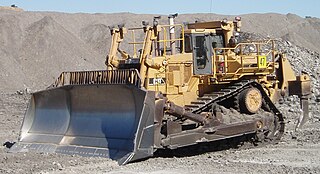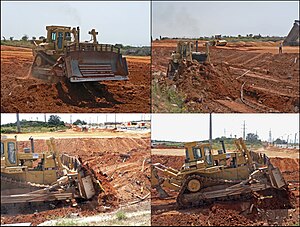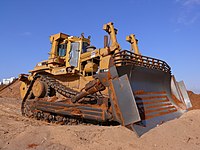
Continuous track or tracked treads are a system of vehicle propulsion used in tracked vehicles, running on a continuous band of treads or track plates driven by two or more wheels. The large surface area of the tracks distributes the weight of the vehicle better than steel or rubber tyres on an equivalent vehicle, enabling continuous tracked vehicles to traverse soft ground with less likelihood of becoming stuck due to sinking.

The Caterpillar D9 is a large track-type tractor designed and manufactured by Caterpillar Inc. It is usually sold as a bulldozer equipped with a detachable large blade and a rear ripper attachment.

Excavators are heavy construction equipment primarily consisting of a boom, dipper, bucket and cab on a rotating platform known as the "house" - although the largest form ever, the dragline excavator, eliminated the dipper in favor of a line and winch.

A bulldozer or dozer is a large, motorized machine equipped with a metal blade to the front for pushing material: soil, sand, snow, rubble, or rock during construction work. It travels most commonly on continuous tracks, though specialized models riding on large off-road tires are also produced. Its most popular accessory is a ripper, a large hook-like device mounted singly or in multiples in the rear to loosen dense materials.

A loader is a heavy equipment machine used in construction to move or load materials such as soil, rock, sand, demolition debris, etc. into or onto another type of machinery.

Heavy equipment, heavy machinery, earthmovers, construction vehicles, or construction equipment, refers to heavy-duty vehicles specially designed to execute construction tasks, most frequently involving earthwork operations or other large construction tasks. Heavy equipment usually comprises five equipment systems: the implement, traction, structure, power train, and control/information.

Pegaso was a Spanish manufacturer of trucks, buses, tractors, armored vehicles, and, for a while, to train apprentices, and have a good brand image, some sports cars. The parent company, Enasa, was created in 1946 and based in the old Hispano-Suiza factory, under the direction of the renowned automotive engineer Wifredo Ricart. In 1990, Iveco took over Enasa, and the Pegaso name became a secondary brand of Iveco.

A grader, also commonly referred to as a road grader, motor grader, or simply blade, is a form of heavy equipment with a long blade used to create a flat surface during grading. Although the earliest models were towed behind horses, and later tractors, most modern graders are self-propelled and thus technically "motor graders".

Caterpillar Inc., also known simply as CAT, is an American construction, mining and other engineering equipment manufacturer. The company is the world's largest manufacturer of construction equipment. In 2018, Caterpillar was ranked number 73 on the Fortune 500 list and number 265 on the Global Fortune 500 list. Caterpillar stock is a component of the Dow Jones Industrial Average.

The IDF Caterpillar D9 — nicknamed Doobi — is a Caterpillar D9 armored bulldozer used by the Israel Defense Forces (IDF). It is supplied by Caterpillar Inc. and modified by the Israel Defense Forces, Israeli Military Industries and Israel Aerospace Industries to increase the survivability of the bulldozer in hostile environments and enable it to withstand attack.

The Caterpillar D11T is a large bulldozer introduced by Caterpillar Inc. in 1986 to replace its D10. Weighing 248,500 pounds (112,700 kg), it is Caterpillar's largest and most powerful bulldozer. Mainly used in the mining industry, it is also employed to push-load scrapers, and rip rock overburden. D11s are manufactured in East Peoria, Illinois.

The Caterpillar D6 track-type tractor is a medium bulldozer manufactured by Caterpillar Inc. with a nominal operating weight of 18 short tons (16 t). The military versions were classified as the SNL G152 medium tractor, under the G-numbers classification system used for army tractors.

The armored bulldozer is a basic tool of combat engineering. These combat engineering vehicles combine the earth moving capabilities of the bulldozer with armor which protects the vehicle and its operator in or near combat. Most are civilian bulldozers modified by addition of vehicle armor/military equipment, but some are tanks stripped of armament and fitted with a dozer blade. Some tanks have bulldozer blades while retaining their armament, but this does not make them armored bulldozers as such, because combat remains the primary role — earth moving is a secondary task.

The Caterpillar D7 is a medium track-type tractor manufactured by Caterpillar Inc. and most commonly used as a bulldozer.

The Caterpillar D8 is a medium track-type tractor designed and manufactured by Caterpillar. Though it comes in many configurations, it is usually sold as a bulldozer equipped with a detachable large blade and a rear ripper attachment.
An idler-wheel is a wheel which serves only to transmit rotation from one shaft to another, in applications where it is undesirable to connect them directly. For example, connecting a motor to the platter of a phonograph, or the crankshaft-to-camshaft gear train of an automobile.

The Caterpillar D5 is a small track-type bulldozer manufactured by Caterpillar Inc. The original D5 series was only produced in 1939. The current D5 series being produced is the D5K.

The Allis-Chalmers D series is a line of tractors made by the Allis-Chalmers Manufacturing Company from 1957 to 1969.
The Komatsu D475A is the second largest bulldozer in the Komatsu line after the D575A, the world's largest production bulldozer. The current version is the 248,240 pounds (112,600 kg), 899 horsepower (670 kW) D475A-8 Tier 4. There are several versions of the D475A that are used in surface mining, open-pit mining, quarries and construction worldwide.

Prior to and during the second world war the US Army called several tractors M1 Medium Tractor. Under the Ordnance Corps these "off the shelf" tractors were meant to tow artillery pieces, so were not equipped with blades like their Engineer counterparts. Eventually these were replaced by purpose built "High Speed Tractors" (HST). Some tractors were equipped with crane attachments for ammunition, and material handling.






















